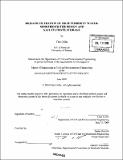Biosand filtration of high turbidity water : modified filter design and safe filtrate storage
Author(s)
Collin, Clair
DownloadFull printable version (28.55Mb)
Other Contributors
Massachusetts Institute of Technology. Dept. of Civil and Environmental Engineering.
Advisor
Susan Murcott.
Terms of use
Metadata
Show full item recordAbstract
Unsafe drinking water is a major cause of water-related diseases that predominantly affect people living in developing countries. The most prevalent water-related disease is diarrhea, estimated to kill 1.8 million children every year and the second largest cause of childhood death. Today there are many technologies available to treat unsafe water; however, most of these are suited for use with low turbidity source water. The treatment of high turbidity water (>50 NTU) is a challenge that was investigated in this research. Biosand filters, based on an intermittent slow sand filtration process, are an established household scale water treatment technology widely used in developing countries to treat low turbidity drinking water. This research investigates modifications to the biosand filter design to promote effective pathogen and turbidity reduction in high turbidity water. During field tests conducted in Ghana, a modified biosand filter with dual sand layers for added filtration achieved the greatest pathogen and turbidity removals. This design was then optimised through laboratory studies at MIT. The dual sand layer biosand filter supports straining and sedimentation of particulate matter from the feed water in a 3-7 cm deep raised upper sand layer prior to biological treatment and further filtration of the water in a 15-16 cm deep lower sand layer. Field testing of the dual sand layer biosand filter showed this filter achieved 59% turbidity reduction, 38% higher than an unmodified control filter; and at least 85% E. coli and 95% total coliform reductions, comparable in performance to unmodified control filters. (cont.) Laboratory testing demonstrated minimum average reductions of 93% turbidity, 97% E. coli and 71% total coliform after filter maturation, comparable to unmodified control filter results. Dissolved oxygen concentration profiling in the laboratory indicated sufficient oxygen diffused through the upper sand layer to the lower sand layer to support biological activity in the lower sand layer. Recommendations for future studies and design optimisation have been made. Recontamination of treated water is also a major concern and it is recommended that the biosand filter be used only as required and filtrate collected in a dedicated container with tight fitting lid and tap dispenser.
Description
Thesis (M. Eng.)--Massachusetts Institute of Technology, Dept. of Civil and Environmental Engineering, 2009. Includes bibliographical references (leaves 126-131).
Date issued
2009Department
Massachusetts Institute of Technology. Department of Civil and Environmental EngineeringPublisher
Massachusetts Institute of Technology
Keywords
Civil and Environmental Engineering.